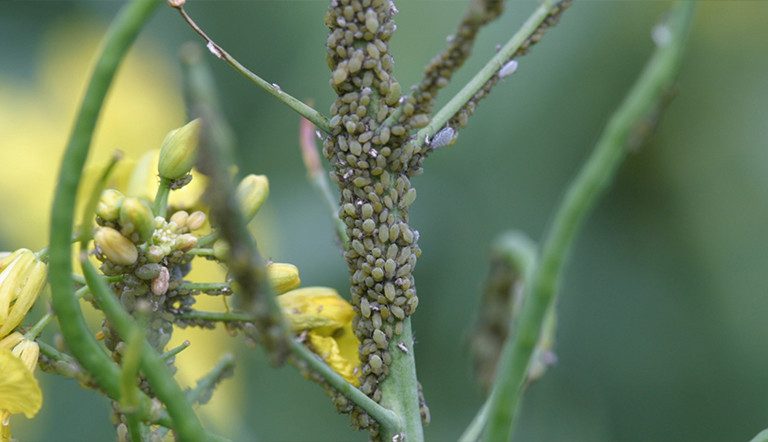
How to Prevent Aphids from Ruining Your Canola Crop

Aphids are one of the most concerning canola pests. They migrate from host plant species and populations can increase quickly when the temperature is high. The canola plant is susceptible to aphid damage from early in the growth season to flowering stage, especially from emergence to the rosette stage.
Aphids feed on plant tissue, using specially developed mouthparts to suck sap from the host plant. Because of the amount of sap sucked from the plant, it starts to wilt and can die. The aphids then move on to the next plant. Aphids can target various plant species but most aphids are fairly host specific. Black bean aphids (Aphis fabae), wheat aphids (Diuraphis noxia) and melon aphids (Aphis gossypii) are serious crop pests. They also transmit certain viral and bacterial diseases.
If aphid populations attack the plant during the rosette phase, the growth of the plant can be hampered. Seed set and podfill can be negatively affected if the aphid infestation is heavy and long lasting during the flowering stage and pod formation.
Aphid damage tends to focus on tender canola leaves, which are severely damaged, becoming malformed and curled. Aphids can also transmit viruses that further arrest plant growth. Infested plants are weak, prone to virus attack and they fail to produce an economic crop.
Aphids excrete a sugary substance called honeydew, which attracts ants, which are often an indicator of aphid infestation. Sooty mould, a black fungus, tends to grow on leaves with excessive honeydew. This negatively affects photosynthesis, reducing yield.
The types of aphids prevalent in South Africa that attack the canola plant

The species of aphids that canola is attacked by in South Africa are the cabbage aphid (Brevicoryne brassicae), green peach aphid (Myzus persicae) and mustard aphid (Lipaphis erysimi).
According to Grain SA, the cabbage aphid is currently the primary species of concern in canola production: “Canola is extremely sensitive to aphid infestation during the early growth stages. Heavy infestation during the flowering and pod forming stages may prevent flower formation and may seriously impair the setting and filling of pods. This has a big influence on yield. If moisture stress occurs it is important to protect canola from aphids.”
The life cycle of the cabbage aphid
According to the Entomology And Nematology Department of the University of Florida, female aphids give birth to female nymphs without mating in warm climates. In temperate climates, in response to low temperature male aphids are also produced and mating takes place. The females lay eggs. “Generations are overlapping, with up to 15 generations during the crop season… The total life cycle duration ranges between 16 to 50 days depending on temperature. The life cycle is shorter at higher temperatures.”
Integrated pest management approach to control aphids
Natural control
How do ladybugs benefit the ecosystem? Bill Kerr, writing for Farmer’s Weekly, notes that “if aphid numbers are low and ladybirds and other biological control agents are present… these bugs will deal with any new arrivals, and can clean up the crop completely.”
Aphids have a large number of natural enemies or predators, including ladybirds, lacewings, spiders and small parasitic wasps. Unfortunately, these beneficial insects can be killed by excessive use of chemical pesticides. It is important to keep pesticide use to a minimum so that natural enemies can thrive. Constant vigilance is necessary though.
Kerr advises spot-spraying if individual plants become infested, leaving the predators to hunt aphids in other areas and attack any colonies which may have been too small to spot.
Cultural control
Weeds that belong to the cabbage family, such as water cress (Nasturtium officinale) and wild mustard (Sinapis arvensis), attract the same aphids and it is generally believed that these must be removed. Keep seed beds clear of weeds at all times. A minimum three-year crop rotation is advised to prevent aphid infestation.
However, in their paper “Management Of Aphids On Canola (Brassica Napus L.) Through Cultural
Practices”, Akbar et al note that aphid infestation in canola can be minimised by the use of companion crops with odorous biochemical properties.
They quote researchers who have reported that intercropping with garlic and onion “had strong pungent effect against aphids and these served as an effective anti-feedant”. Others have observed that fennel seed proved effective in reducing the aphid infestation. Research done for this paper supported the statement that aromatic crops with repellant properties can be used as a border or intercrop for keeping the aphid infestation low and thus ensure better yields.
Akbar et al add the disclaimer that while cultural methods to control insect pests are among the primary pest management tools of an IPM strategy, “their potential role to manage the insect pest needs careful planning and further explorations considering the pest behavior and effectiveness of the relative companion crops.”
Chemical control
When growing canola, farmers wondering how to get rid of cabbage aphids or how to manage/control aphids without affecting other beneficial insects might consider ADAMA’s Klartan® 240 EW. It is effective at low dose rates and has low toxicity for bees and predatory insects. (In some countries it is even registered to control mites in beehives and is therefore suited to an IPM programme.)
We recommend that growers not wait until infestations reach high levels before application. An advantage of Klartan 240 EW application is that American bollworm will also be controlled if present at time of application.
Check out our Klartan product overview and visit our Crop Protection section for more helpful advice on managing pests.
Image sources: